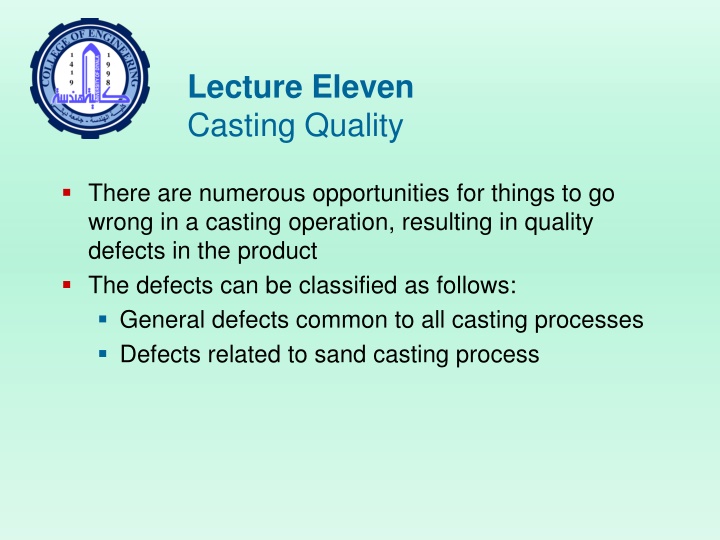
Common Casting Quality Defects and Inspection Methods
Learn about common defects in casting processes, including misrun, cold shut, cold shot, shrinkage cavity, sand blow, pin holes, penetration, and mold shift. Explore inspection methods for ensuring casting quality.
Download Presentation

Please find below an Image/Link to download the presentation.
The content on the website is provided AS IS for your information and personal use only. It may not be sold, licensed, or shared on other websites without obtaining consent from the author. If you encounter any issues during the download, it is possible that the publisher has removed the file from their server.
You are allowed to download the files provided on this website for personal or commercial use, subject to the condition that they are used lawfully. All files are the property of their respective owners.
The content on the website is provided AS IS for your information and personal use only. It may not be sold, licensed, or shared on other websites without obtaining consent from the author.
E N D
Presentation Transcript
Lecture Eleven Casting Quality There are numerous opportunities for things to go wrong in a casting operation, resulting in quality defects in the product The defects can be classified as follows: General defects common to all casting processes Defects related to sand casting process
General Defects: Misrun A casting that has solidified before completely filling mold cavity
General Defects: Cold Shut Two portions of metal flow together but there is a lack of fusion due to premature freezing
General Defects: Cold Shot Metal splatters during pouring and solid globules form and become entrapped in casting
General Defects: Shrinkage Cavity Depression in surface or internal void caused by solidification shrinkage that restricts amount of molten metal available in last region to freeze
Sand Casting Defects: Sand Blow Balloon-shaped gas cavity caused by release of mold gases during pouring
Sand Casting Defects: Pin Holes Formation of many small gas cavities at or slightly below surface of casting
Sand Casting Defects: Penetration When fluidity of liquid metal is high, it may penetrate into sand mold or core, causing casting surface to consist of a mixture of sand grains and metal
Sand Casting Defects: Mold Shift A step in the cast product at parting line caused by sidewise relative displacement of cope and drag
Foundry Inspection Methods Visual inspection to detect obvious defects such as misruns, cold shuts, and severe surface flaws Dimensional measurements to insure that tolerances have been met Metallurgical, chemical, physical, and other tests concerned with quality of cast metal
